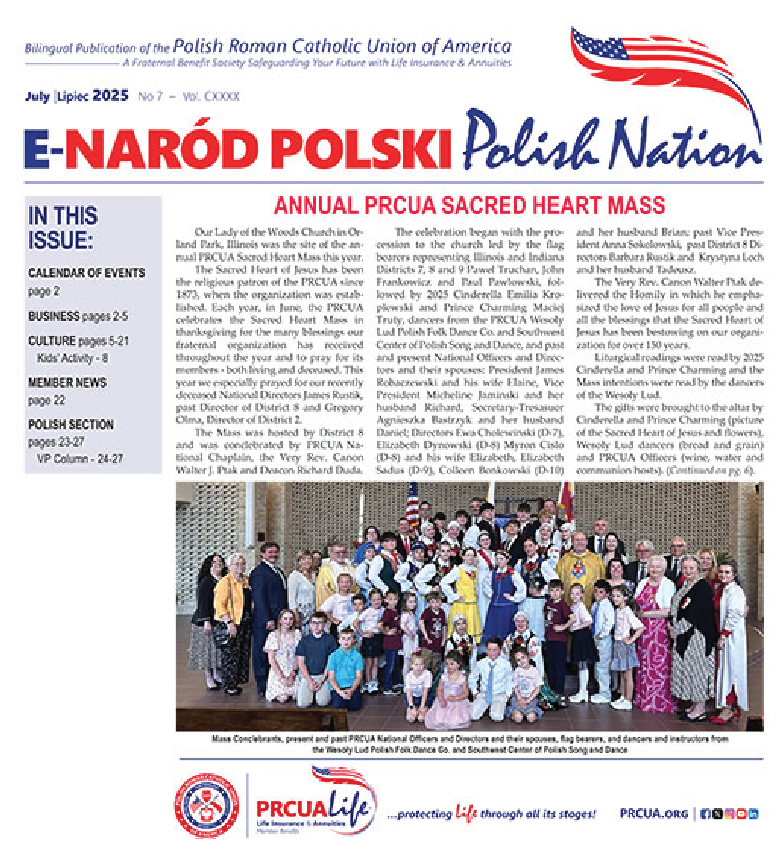As we ponder if English school will resume at all or in a hybrid version, we wonder when our Polish language and dance classes will safely be able to resume. In the meantime, let’s keep our fingers crossed that extracurricular activities will resume safely and sooner than later. Optimistically, we introduce our “Back to School” Promotion which we encourage all potential students to take advantage of.
July was a relatively quiet month for the Home Office. It often is. This year though, the quiet seemed very needed, very welcomed as we continued to cultivate our business programs – incorporating our admin program, restructuring our New Business Department, condensing the Sales program – all to provide quicker and more efficient ways to serve our members and of course, the longevity of the PRCUA. With the July 15 tax deadline a distant memory, we have a new PRCUALife Annuity Series – Red, White and Blue – in place and we encourage you to review our rates. At a time when again a pandemic brought the world to a standstill, testing not only our health but our economic resolve, we individually and collectively realized the importance of our everyday investment in our personal world. Just as the virus continues to mutate to adjust to an ever-changing environment, future generations continue to adapt their family traditions and beliefs into an ever-changing social climate. As for the former, I hope it is eradicated. As for the latter, I hope mainstays such as the PRCUA, PMA and the like, continue to grow and prosper.
Lately, I have been avoiding the news on television. I find it mostly negative – coronavirus counts are up, deaths are up, etc. Standing on the soap box of freedom, we hear our fellow Americans screaming about the injustices in our country – “mask-wearing and social distancing” (isn’t this sound health advice in a world run by corona), gun violence, racism, etc. I’ll personally check the news just for the weather on my days off so I know what projects I can check off on Richard’s and my “to do list.” As for traffic reports when I’m in transit, the radio provides up-to-the minute information. Sometimes, when the television serves as background noise, I hear something that gives me another jolt of reality. For example, a nurse reporting that a 30 year old patient died in her arms from the coronavirus after admitting that he made a mistake thinking the virus was a hoax. His passing proved otherwise. It seems that some 20-30 year olds are tempting fate – obviously doing their own experiments – inviting someone diagnosed with Covid-19 to see if it is really contagious. If I am in a dream, please wake me up. Why can’t we as nation follow the mandates to contain the virus and have life slowly return to normal as it has in countries outside of the U.S.? Isn’t there a middle ground where one is cautious enough to live what is the new normal? In the spirit of hope and positivity, I invite you to read the article by Prof. dr Marek Rudnicki. Limiting my article, I welcome the sound advice and updated information of this renown health professional and I thank him for sharing his knowledge with us. Please see below article: “It’ll get worse before it gets better”.
Get well wishes for a speedy recovery to Ted Klamerus, Michael Turkiewicz, Evelyn Cedzidlo, and anyone else suffering during this crisis.
Wedding anniversary wishes to all celebrating in August, especially to past PRCUA Presidents and their lovely wives – the Dykla’s, Ozog’s and Drobot’s; Secretary-Treasurer Agnieszka Bastrzyk and her husband, Daniel – as well as to my Prince Charming (32 years and going strong), family and friends including the Lech’s, the Pazdziora’s, the Kroplewski’s and so many others for whom the month is special. Birthday wishes galore during this last month of summer – especially to our PRCUA President – you aren’t getting older, you are getting wiser (who shares the date with my grandson, Cole Pearson). Happy birthday Jim (and Cole) and to so many other special people! All the best to all of you! Sto lat!
“It’ll get worse before it gets better”, by Marek Rudnicki, MD, PhD
These words of President Trump a few days ago may be the motto of the next months in our difficult fight against COVID-19. Will the temporary restrictions of the pandemic end with another wave of illness and death? How is it possible that our entire modern world, mighty in civilization, technologies, space travel, the power of its armies, atomic and hydrogen bombs, is not able to cope with one small virus, invisible to the naked eye? It turns out that, at least at some stage, the combined forces of the 21st century world are unable to successfully counter the unknown threat that has emerged as the SARS-CoV-2 coronavirus.
Where are we, then, after more than 6 months of fighting the coronavirus that has taken more than 600,000 lives, made over 15 million people sick, and caused costs beyond all possible imaginations by politicians, economists and even futurists talking about catastrophes for the world? There is no talk of the increasingly available information that the number of infected people is 6 to 24 times greater than the data currently reported in the media based on virus testing.
The most powerful minds in the world, regardless of the country and political system in which these people work, have been involved in developing effective measures to combat COVID-19. The scientists have a three-part focus:
- What to do so that people do not get sick and how to isolate sick people, protecting entire environments against future outbreaks of a pandemic
- How to quickly diagnose those whom the virus has attacked
- What actions to take so that those who fall ill can quickly recover, or in other words – how to work out the best and most effective therapeutic methods in many respects. What treatment should be used to minimize the long-term consequences of COVID-19 infection?
Social distancing, masks, hand washing, limiting the possibility of meetings and traveling were the first recommendations of epidemiologists. However, a method is needed that will protect us from getting sick. And as with polio or measles several decades ago, our hope is in an effective vaccine. There are currently many vaccines for the novel coronavirus under development and in clinical trials, but they will not be ready for use for many months.
The works of a group of scientists from Oxford University in the UK seem to be the most advanced, supported by the pharmaceutical company AstraZeneca. A substance called ChAdOx1 nCoV-19 is being tested in many centers. It is made from a genetically modified virus that causes chimpanzees to catch a cold. However, it has been changed so that it does not cause human infections and that it “looks” like a coronavirus to the immune system. Scientists have “mixed” this virus with a small protein chain that comes from the coronavirus, which is responsible for attacking the cells of an infected person.
The vaccine not only produces antibodies that bond to the surface of the virus and neutralize it, but it also triggers the production of T cells, white blood cells that help the immune system work in tandem with the antibodies to fight infection. So basically, the vaccine “deceives” the affected organism by pretending to be a real virus, but without doing the damage we normally see. It stimulates the immune system to produce antibodies and white blood cells (T lymphocytes) – they are to contribute to the fight against coronavirus in the body of a sick person. Although the final results of the next phases of clinical trials may not be known until the end of the year, vaccine pre-orders from various countries have already exceeded several billion doses.
The American company Moderna has added a vaccine called mRNA-1273 to the third phase of research on 30,000 people. It is a modern type of acquired immunity drug that uses a ribonucleic acid (RNA) sequence to encode a pathogen’s protein. To date, there is no vaccine in the world approved for human use based on this technology. According to the New England Journal of Medicine, vaccinated patients were able to develop a “strong immune response”.
There is a report on the treatment of sick patients with Covid-19 with interleukin 7 (IL-7). The applied therapy increases the number of circulating lymphocytes, leading to an increase in the immune resistance of the patient’s organism.
The treatment uses SARS-CoV-2 neutralizing antibodies, developed in the bodies of patients who have undergone COVID-19, to treat other patients and to prevent infection in people that are at particular risk. Generally, such antibodies are prepared for use and approved as a therapy in less time than with standard drugs.
All possible and known therapies are still – and will continue to be – aimed mainly at treating complications of viral infection. However, they do not strike (or at least no convincing data are available) the very mechanism of the viral attack and its spread within the human body.
There should be no doubt that we, as the 21st century civilization with the enormous power of science and technology, will win this war. The question is: what will be its cost, both human and economic, and how long will this war last. Unimaginable resources around the world are involved in it, and we should, on the one hand, follow the recommendations of those who know it well, and on the other, wait for the announcement of an effective weapon against COV

